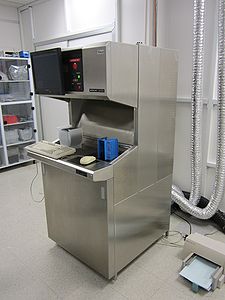Specific Process Knowledge/Characterization/KLA-Tencor Surfscan 6420: Difference between revisions
Appearance
| Line 9: | Line 9: | ||
'''The user manual and contact information can be found in LabManager:''' | '''The user manual and contact information can be found in LabManager:''' | ||
http://labmanager.danchip.dtu.dk/function.php?module=Machine&view= | http://labmanager.danchip.dtu.dk/function.php?module=Machine&view=view&page_id=169 | ||
== Process information == | == Process information == | ||
Revision as of 12:19, 3 June 2013
Feedback to this page: click here
KLA-Tencor Surfscan 6420

The KLA-Tencor is a surface analysis instrument for detecting, couting and sizing of particles, i.e. light point defects. A broad range of particles size from 0.15 µm to greater than 3 µm can be measured on a polished silicon surface with or without or epitaxial layers. The particle contamination in thin films like nitride, thermal oxide and polymer or resist can also be inspected. The system will remove small surface roughness so it will not count as particle contaminations.
The user manual and contact information can be found in LabManager:
http://labmanager.danchip.dtu.dk/function.php?module=Machine&view=view&page_id=169
Process information
| Purpose |
| |
|---|---|---|
| Performance | Particles size |
|
| Througput |
| |
| Repeatbility |
| |
| Process parameter range | Process Temperature |
|
| Substrates | Batch size |
|
| Substrate materials allowed |
|
